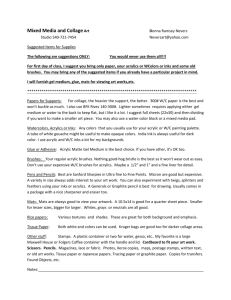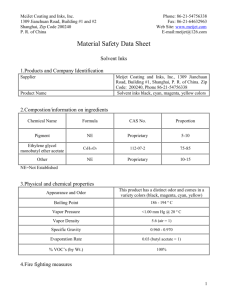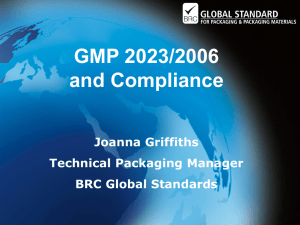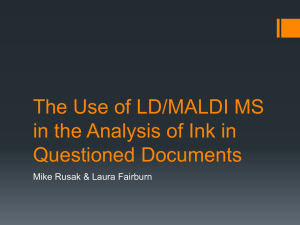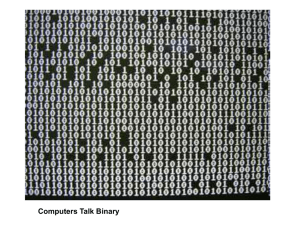SpecTruLiteTM Organic Inks
advertisement
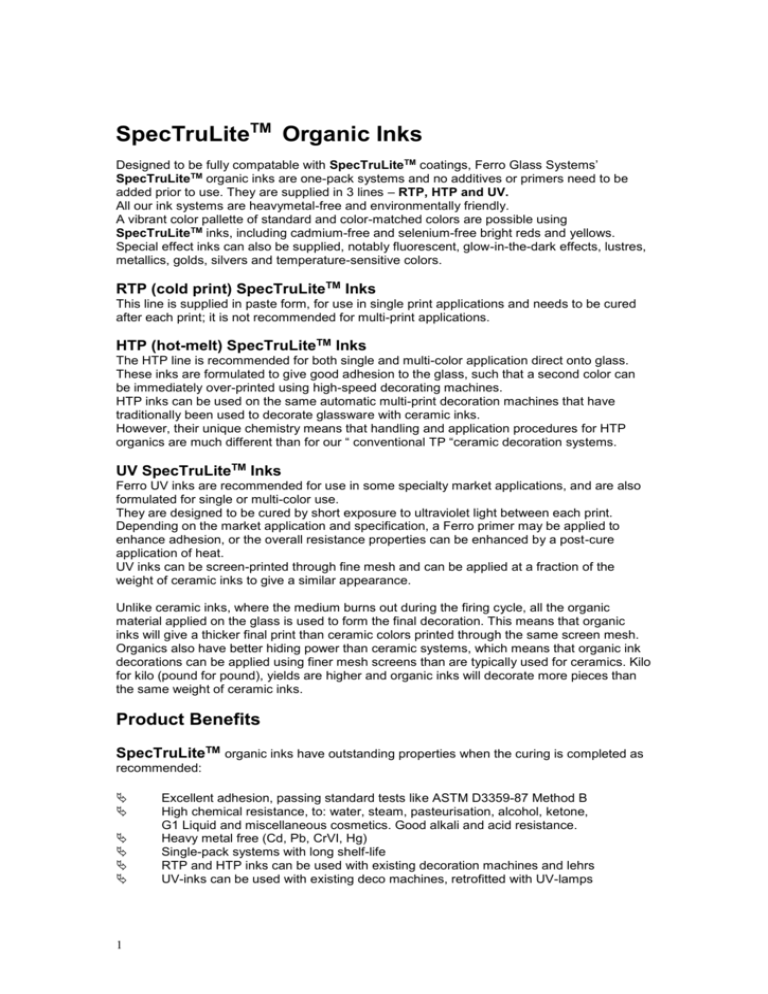
SpecTruLiteTM Organic Inks Designed to be fully compatable with SpecTruLiteTM coatings, Ferro Glass Systems’ SpecTruLiteTM organic inks are one-pack systems and no additives or primers need to be added prior to use. They are supplied in 3 lines – RTP, HTP and UV. All our ink systems are heavymetal-free and environmentally friendly. A vibrant color pallette of standard and color-matched colors are possible using SpecTruLiteTM inks, including cadmium-free and selenium-free bright reds and yellows. Special effect inks can also be supplied, notably fluorescent, glow-in-the-dark effects, lustres, metallics, golds, silvers and temperature-sensitive colors. RTP (cold print) SpecTruLiteTM Inks This line is supplied in paste form, for use in single print applications and needs to be cured after each print; it is not recommended for multi-print applications. HTP (hot-melt) SpecTruLiteTM Inks The HTP line is recommended for both single and multi-color application direct onto glass. These inks are formulated to give good adhesion to the glass, such that a second color can be immediately over-printed using high-speed decorating machines. HTP inks can be used on the same automatic multi-print decoration machines that have traditionally been used to decorate glassware with ceramic inks. However, their unique chemistry means that handling and application procedures for HTP organics are much different than for our “ conventional TP “ceramic decoration systems. UV SpecTruLiteTM Inks Ferro UV inks are recommended for use in some specialty market applications, and are also formulated for single or multi-color use. They are designed to be cured by short exposure to ultraviolet light between each print. Depending on the market application and specification, a Ferro primer may be applied to enhance adhesion, or the overall resistance properties can be enhanced by a post-cure application of heat. UV inks can be screen-printed through fine mesh and can be applied at a fraction of the weight of ceramic inks to give a similar appearance. Unlike ceramic inks, where the medium burns out during the firing cycle, all the organic material applied on the glass is used to form the final decoration. This means that organic inks will give a thicker final print than ceramic colors printed through the same screen mesh. Organics also have better hiding power than ceramic systems, which means that organic ink decorations can be applied using finer mesh screens than are typically used for ceramics. Kilo for kilo (pound for pound), yields are higher and organic inks will decorate more pieces than the same weight of ceramic inks. Product Benefits SpecTruLiteTM organic inks have outstanding properties when the curing is completed as recommended: 1 Excellent adhesion, passing standard tests like ASTM D3359-87 Method B High chemical resistance, to: water, steam, pasteurisation, alcohol, ketone, G1 Liquid and miscellaneous cosmetics. Good alkali and acid resistance. Heavy metal free (Cd, Pb, CrVI, Hg) Single-pack systems with long shelf-life RTP and HTP inks can be used with existing decoration machines and lehrs UV-inks can be used with existing deco machines, retrofitted with UV-lamps Recommendations for Use Substrate cleanliness As with SpecTruLiteTM coatings, the cleanliness of the substrate is extremely important. Dirt, dust, fingerprints, fat, wax, etc. on the ware or in the workplace environment, can cause surface defects or performance problems. Most cold end coatings used in the glass industry are not compatable with these decorative inkson glass containers. Cold end coatings based on polyethylenes, soaps, oleic acid or stearates are known to cause adhesion problems with the cured print. This is likely to occur when the cold end coatings are heavily applied. The SpecTruLiteTM ink often adheres to the cold end coating but the glass/cold end coating interface fails, particularly when the ware is exposed to water. Therefore, it is strongly recommended that either no cold end coating, or a light application of cold end coating is used. Oleic acid based cold end coatings should be avoided. If you are not sure of the coating applied on the substrate, it can be removed by running it through a lehr set at a typical glass enamel profile. This should be operated at a temperature of at least 450°C (800°F) for at least 30 minutes. Application and Handling SpecTruLiteTM HTP hot-melt inks are supplied at screen-ready viscosity. They must be melted prior to use – off-line melting is recommended - and applied through a heated stainless steel screen. We recommend melting sufficient ink for each shift, since ink that has been heated and melted repeatedly will thicken and become difficult or impossible to print. Screen temperatures should be maintained at 88-95°C (185-205°F) during printing with setbacks for idle periods. A heated squeegee should also be used to keep the ink in a fluid state and to optimise the printing behaviour. Higher temperatures must be avoided because of the danger of curing the ink in the screen. The screens should be made with good tension, so that the sceen ‘snaps back’ quickly when pressed and released. Soft or limp screens usually result in smearing or pick-off of prints during multi-color printing. This is because the hot screens of the second or later colors drag across the previous prints and cause them to re-melt. This problem can be aggravated by slow line speeds (<45 bottles per minute). SpecTruLiteTM RTP inks are liquid at room temperature and supplied in paste form. They can be thinned if required with Ferro recommended thinners, usually at additions of 1-5%, and can be printed through polyester or stainless steel screens, 160-305 mesh. SpecTruLiteTM UV inks are designed to be applied by conventional screen-print machines, typically 150-215 tpi, fitted (or retro-fitted) with UV-cure lamps between each print station. Application and handling should be the same as with any other liquid screen print ink. However, safe handling procedured for working with UV-curable materials should be observed at all times. Consult the relevant MSDS for further information. Screens should also be set higher off the glass for printing with organic inks. Offset heights of 6mm (0.25 inch) or higher are not unusual when screen printing organics. The final setting is dependant on the screen and the ware itself. Squeegee pressures should be moderate (lower than for ceramic inks), since organic inks thin under shear and actually print better at higher speeds. Recommended squeegee durometer hardness is 50-80. Both UV and RTP lines contain a series of popular standard intermixable colors. 2 Screen Cleaning Alcohol and ketones, such as acetone and MEK are good cleaning solvents. Commercial screen wash blends containing ketones and acetates are found to be very effective. Mineral Spirits are not recommended Cure Conditions SpecTruLiteTM RTP and HTP inks are formulated to cure completely when the temperature of the glass reaches 200°C (392°F). The time and temperature settings in the lehr or curing oven will vary from plant to plant. Best results are obtained when the heat is applied as quickly as possible. When using a traditional glass lehr to cure organics, this can be typically set up with heat in the first zones and the latter zones may not be needed. Slow heat-up profiles that are often used for ceramic inks to ensure good medium burn-out, are not needed with organics because there is nothing to burn out. In fact, such slow profiles may give poorer results by delaying full cure and allowing the prints to flow too much! The application of too much heat work – for example either from too high a lehr temperature setting or a partially empty lehr – can cause organic inks to decompose. The first sign of this fault is when white or light colors begin to show a yellow tone. This can be corrected by reducing temperature, increasing the volume of glass, or speeding up the belt. UV inks are designed for high speed application and require as little as 200 mill joules of energy to cure the colors between each print. A 300 watt “H” bulb is recommended for best results and adhesion after curing. After printing, an additional heat treatment may be used to enhance the bonding of the ink to the glass surface. The heat can be applied by oven, radiant heaters or a glass lehr. The only requirement is that the temperature of the glass is raised to 200°C (392°F) to enhance the bonding to the glass. The decision to apply a heat bump is influenced by the final market and product specification required. We always recommend a good testing regime, to ensure that the application of the inks meets the final market requirements. For all our inks, the cure cycles required will vary depending on the type, configuration and set up of the lehr or oven. Typically, cycles of 200°C (392°F) for 20 mins. are recommended as a good starting point. Storage Conditions All SpecTruLiteTM inks should be stored in sealed containers at or below 25°C (78°F). Storage at higher temperatures will shorten the shelf life. Ferro inks should be good for 6 months from date of manufacture, when correctly stored under recommended conditions. Refer to the product safety sheets before using. HTP inks that have been melted for use should be used up completely. Repeated melting will shorten ink-life and give unsatisfactory results. when our customers succeed…….. .……. we succeed 3

